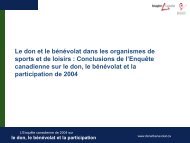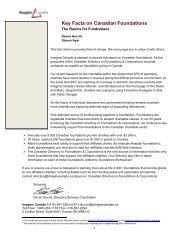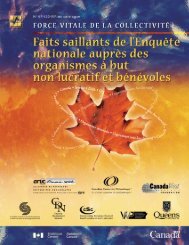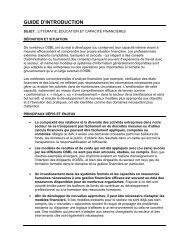Giving and Volunteering in Ontario - English - Imagine Canada
Giving and Volunteering in Ontario - English - Imagine Canada
Giving and Volunteering in Ontario - English - Imagine Canada
- No tags were found...
Create successful ePaper yourself
Turn your PDF publications into a flip-book with our unique Google optimized e-Paper software.
CSGVP: 07GIVING AND VOLUNTEERING IN ONTARIOFigure 2.20). Other forms of help that were most likely to be provided at least once a week<strong>in</strong>cluded work at someone’s home (27% provided this help on a weekly basis) <strong>and</strong> provid<strong>in</strong>ghealth-related or personal care (27%). Provid<strong>in</strong>g help <strong>in</strong> the form of paperwork tended to beless frequent than other forms of assistance (25% of Ontarians engaged <strong>in</strong> this type ofactivity only a few times throughout the year).Both the likelihood <strong>and</strong> the frequency of help<strong>in</strong>g others directly are <strong>in</strong>fluenced by personal<strong>and</strong> economic characteristics, such as age, marital status, education, <strong>and</strong> <strong>in</strong>come. Forexample, the likelihood of help<strong>in</strong>g others generally decreases with age, rang<strong>in</strong>g from a highof 85% among Ontarians aged 15 to 34 to a low of 64% among Ontarians 65 <strong>and</strong> older (seeTable 2.3). However, older Ontarians were most likely to help others on a weekly basis(41%).Ontarians who were s<strong>in</strong>gle were the most likely to help others directly (83%). Those whowere widowed were the least likely to do so (59%) but were the most likely to help others onat least a weekly basis (41%).Ontarians with less than a high school education were least likely to help others directly(75%) while those with a postsecondary diploma or university degree were the most likelyto help (87%). However, those with only some postsecondary education were the most likelyto help others on a weekly basis (45%).Ontarians with annual household <strong>in</strong>comes of $20,000 or less were the least likely to helpothers directly (68%). This number generally rose with household <strong>in</strong>come, reach<strong>in</strong>g a highof 85% among those with household <strong>in</strong>comes of $100,000 or more. However, Ontarianswith household <strong>in</strong>comes between $20,000 <strong>and</strong> $39,999 were the most likely to help otherson a weekly basis (35%).GIVINGANDVOLUNTEERING.CA36
















